July 2017
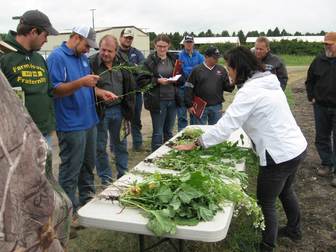 Interest in using cover crops and building soil health seems to be growing among farm producers. Registrations filled quickly for the Soil Health Field Day June 28 at the U of M West Central Research and Outreach Center at Morris. The next day, June 29, farmers and agency staff filled the large meeting room at the Renville Community Center to hear about cover crops and the experiences of local farmers. Photo: WCROC field day visitors examine cover crop samples being described by Marisol Berti, Professor of Forage and Biomass Crop Production at NDSU.
Most agree on the benefits of cover crops: Soil protection from wind and water erosion, increased soil organic matter, root 'tillage', nitrogen control, water infiltration. But to provide economic incentive, researchers are looking for more ways to cash in on cover crops. For example, camelina yields a healthy, tasty edible oil. It reduces nitrogen leaching in the soil, and also offers pollinator benefits, not to mention bio-fuel for jets. Adding cattle to a farm can generate income from cover crop forage.
Once people hear an amazing statistic about soil biology, they begin to appreciate the value of building soil health. One cup of healthy soil is said to contain nine billion microbes. Healthy soil is a living biobass that helps both crop production and water quality. The farmer panel at the Renville cover crop event agreed that while getting started can be challenging, the results are well worth the effort.
Back to top
|
 A 4R Nutrient Management field day will be held July 25 at the Dave Legvold farm near
Northfield. 4Rs - Right source, Right rate, Right time, Right place - uses best management practices that optimize the efficiency of fertilizer use. The Minnesota Agricultural Water Resource Center is hosting the event and coordinating advance
registration. There is no cost to attend, with expenses being covered by sponsors including The
Mosaic Company, Environmental Tillage Systems and The Fertilizer Institute.
Speakers include: Tim Radatz of the MAWRC, Mark Dittrich of
the MDA, Jeff Vetsch of the University of Minnesota, Melinda Sposari of TF, Steve Emory of CPS, and Adam Herges of Mosaic. CEUs will be available for Certified Crop Advisors in
attendance. Photo, KYMN radio: Dave Legvold receives Minnesota Agricultural Water Quality Certification at the Conservation Technology Information Center field day at his farm in 2015. Register here.
Back to top
|
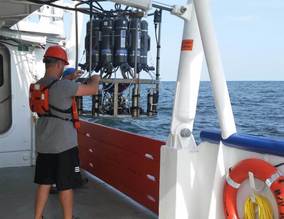 Federal scientists forecast that this summer’s Gulf of Mexico dead zone – an area of low to no oxygen that can kill fish and other marine life – will be approximately 8,185 square miles, or about the size of New Jersey. This would be the third largest dead zone recorded since monitoring began 32 years ago – the average Gulf dead zone since then has been 5,309 square miles. - NOAA news release, 7/20/17. (NOAA photo).
This year’s predicted large size is due mainly to heavy May stream flows, which were about 34 percent above the long-term average and carried higher-than-average nutrient loads. The USGS estimates that 165,000 metric tons of nitrate – about 2,800 train cars of fertilizer – and 22,600 metric tons of phosphorus flowed down the Mississippi and Atchafalaya rivers into the Gulf of Mexico in May. The USGS operates more than 3,000 real-time stream gauges, 60 real-time nitrate sensors, and tracks trends in nutrient loads and concentrations throughout the Mississippi-Atchafalaya watershed, which drains parts or all of 31 states.
To help reduce nutrient runoff, NOAA provides information to farmers through its Runoff Risk Advisory Forecasts, which tell them when to avoid applying fertilizers to their croplands. Minnesota and other states in the region have developed strategies toward achieving the goal of a 45 percent reduction in phosphorus (by 2025) and nitrogen (by 2040, with interim goal of 20 percent by 2025).
Back to top
|
 Similar to other major watersheds in the Minnesota River Basin, Hawk Creek shows a stark contrast between start and finish. It begins at Eagle Lake north of Willmar, and flows through a chain of three lakes before its 65-mile journey southwest to the Minnesota River. From the lakes bordering the north central hardwoods region, it flows through the fertile prairie pothole region and into the river, a fall of nearly 300 feet.
A regional park designation and playground project at Robbins Island Park in Willmar is renewing interest in water quality in the lakes: Willmar, Swan, and Foot. In 2008 and 2009 the Hawk Creek Watershed Project received Surface Water Assessment Grant to monitor all major lakes in the upper watershed. A reassessment of the data may lead to Willmar Lake joining Swan Lake on the MPCA's impaired waters list.
The presentation "Willmar chain of lakes - past, present, future" was featured at the June 23 meeting of the Hawk Creek Watershed Project. It describes how in the early years the lakes became severely polluted from raw sewage and dump sites. Restoring them became a popular topic in the mid-1950s and 60s. Dredging a portion of Foot Lake in the 1970s has greatly improved fishing and aquatic recreation. Clean-up efforts and better stormwater management hold promise for the future. The Board of Water and Soil Resources summer tour plans include a stop at Robbins Island Park in Willmar Aug. 23 to hear about the chain of lakes and regional park. (Aerial photo by Bruce Jaeger. From bottom: Foot, Willmar, Swan, Skataas, Eagle)
Back to top
|
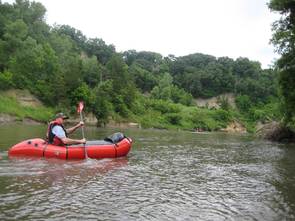 Redwood, Cottonwood rivers
If the weather forecast had cooperated a little better, the June 22 paddle event on the Cottonwood River would have seen a record turnout. Kerry Netzke, Redwood-Cottonwood Rivers Control Area director, said 74 had signed up for the annual expediton, with 48 making it out on the river.
Despite a rain shower at the start and the usual watery adventures along the way, the paddlers enjoyed pleasant temperatures, no mosquitoes, and a swift current at 2,500 cubic feet per second. They started from a canoe launch area south of Essig and paddled to Flandreau State Park in New Ulm and a picnic lunch. A paddle event on the Redwood River June 20 drew 35 people.
"This is our way of providing education and outreach, by getting people out on the river," Kerry says. RCRCA owns four canoes and three kayaks, which can be rented for $10 per day. Along with the outreach activities, RCRCA staff are currently busy with sampling, including a Surface Water Assessment Grant covering 24 streams and 10 lakes in the two watersheds. For more information about the rentals contact Kerry at 507-532-1325, kerry.netzke@rcrca.com. Photo: Pat Schumacher of New Ulm maneuvers his inflatable kayak. "Rollin' on the river," New Ulm Journal, June 26.
|
 West branch Lac qui Parle River
A small flotilla of kayaks and canoes paddled up and down a portion of the West Branch Lac qui Parle River on June 29. They paddled about 2-1/2 miles upstream from Veteran’s Park in Dawson, returning downstream in time for a picnic lunch. The Lac qui Parle-Yellow Bank Watershed District staff grilled brats, burgers, and hot dogs with some side dishes and chips, followed
by ice cream floats. "Overall, it was a mostly overcast but calm day," said Mitch Enderson, district coordinator. "The sun peaked out a little bit and the temperature, water levels, and current
were perfect for the trip. We had 12 people go along,
half in kayaks and half in canoes."
Back to top
|
EPA approves Chippewa River Watershed TMDL report
The U.S. EPA has approved the Chippewa River Total Maximum Daily Load report. The final TMDL is posted on the Chippewa
River Watershed web page along with the EPA approval letter and decision
document. In March, the Chippewa River Watershed Restoration and Protection Strategy report was
approved by MPCA, and is also posted on
the Chippewa
River Watershed web page.
Chippewa
County to use partnership loan for septic upgrades
The Minnesota Pollution Control Agency recently approved a
$200,000 loan to Chippewa County for septic system upgrades. This loan is part
of the Clean Water Partnership program funded by the Minnesota Legislature and
administered by the MPCA. Chippewa County will use the funding for low-interest loans to residents for
upgrading sub-surface sewage treatment systems. These upgrades will help reduce
phosphorus, nitrogen, bacteria and other pollutants flowing to lakes and
streams. See the Clean Water Partnership webpage page for
more information.
Paddlers brave heat to cover 143 miles on Minnesota River
Despite "brutally hot" weather June 10, about 155 paddlers in 12 groups collectively covered 143 miles of the Minnesota River in DNR's annual "Paddle the Minnesota River in a Day" event. Coordinator Alexander Watson looks forward to 2018 and better weather.
Attend a water quality town hall meeting this summer and fall
Ten water quality town hall meetings scheduled this summer and fall will offer Minnesotans an opportunity to discuss the water quality challenges facing their communities and our state, learn from experts, and engage with policymakers. The meetings are free to attend and open to the public. Each meeting will run from 6:30-8:30 p.m. with registration beginning at 6 p.m. No advance registration is necessary. A complete list of dates and locations is available online.
Back to top
MPCA's Pete Fastner retiring after 37-year career
Pete Fastner is retiring July after 37
years of service with the MPCA. Many know Pete for his dedicated work in the nonpoint
program’s state Clean Water Partnership grants and loans, and federal Section 319
grant programs. Pete also coordinated the semimonthly Water Issues
presentations at the MPCA where numerous guest speakers share important information on
environmental topics. An open house will be Monday, July 10, 2-4 p.m., in the MPCA St. Paul board room, with a brief program at 2:30 p.m.
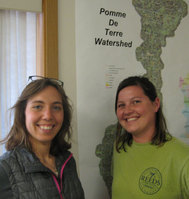 New faces at Pomme de Terre River Association
The Pomme de Terre River Association office in Morris recently welcomed new staff replacing Jared House. Stephanie Adams (left in photo) arrived in January as the new administrator. Nicole Erickson started in May as technician. Originally from Ohio, Stephanie previously worked with a watershed organization in Montana. Nicole is from Brainerd and recently graduated from University of Wisconsin-Stevens Point.
Kara Kaehler moved from the DNR office in Spicer to take a newly-created administrative staff job with the Middle Fork Crow Watershed District.
Scott Mackenthun started in March with DNR fisheries in New Ulm, replacing Lee Sundmark who has retired.
Jeremy Maul is the new BWSR Board Conservationist in the New Ulm office, covering Chippewa, Renville, McLeod, Brown and Redwood counties. He has been with BWSR for the past 10 years, and prior to that, the Fillmore County SWCD.
Back to top
|
 The Dept. of Agriculture has selected two projects to receive Clean Water Fund research contracts. Thirteen proposals were submitted totaling more than $2.8 million in requested funds. The two selected projects total $556,703.
Dr. Jeffrey Strock, U of M Southwest Research and Outreach Center, Lamberton, will research “Integrated Landscape Management for Agricultural Production and Water Quality.” It establishes a site where the impact of multiple, combined BMPs can be measured. Nitrogen, phosphorus, and sediment will be monitored individually and cumulatively from in-field, edge-of-field, and in-stream BMPs.
Research data collected will be used to determine the hydrologic, nitrogen, phosphorous, and sediment reduction potential of these integrated strategies and their potential for meeting Minnesota's Nutrient Reduction Strategy goals. Additionally, the project will demonstrate the ability to meet the dual goals of maintaining farm productivity while improving watershed conditions and water quality. Photo: Dr. Jeffrey Strock at field day in 2014 on Brian Hicks farm in Redwood County.
Dr. Gary Sands, U of M Dept. of Bioproducts and Biosystems Engineering, will research “Improving Design, Performance, and Implementation of Saturated Buffers.” This project seeks to increase both the effectiveness and use of saturated buffers as a BMP to reduce nitrogen loss from artificially drained agricultural lands. It will develop a planning tool to enable local professionals and conservation staff to integrate key site information into the decision-making process for siting and designing saturated buffers.
Additional information is online at mda.state.mn.us/cleanwaterfund/research. - Dept. of Agriculture news release, 6/13/17.
Back to top
|
The MPCA is requesting comment on possible amendments to chapter
7002 and 7083 rules governing water quality fees. This includes fees for
municipal and industrial wastewater permits, noncontact cooling water permits,
stormwater permits, feedlot permits, septic systems, environmental review,
variances, and more. The MPCA may make rule changes to some or all of these
fees.
The notice is available by visiting the MPCA public notice webpage. Additional information
about this rulemaking, including two fact sheets, “Funding Minnesota’s water
protection work” and “Public input needed on adjusting fees for water programs”
are available on the Water Quality Fee Rule webpage.
The MPCA published notice in the June 26 State Register. The public comment period for
this notice closes at 4:30 p.m. on Monday, Aug.14. A stakeholder video
conference on this rulemaking will be held on Monday, July 24 from 2-4 p.m. and
again from 6-8 p.m., at the MPCA St. Paul office and regional offices. The
purpose of the meeting is to share information about this rulemaking so that
stakeholders are able to provide verbal input at the meeting and written
comments by Aug. 14.
Back to top
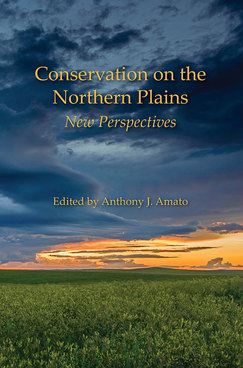 In a new book edited by Dr.
Anthony Amato, Southwest State University, a collection of 11 essays by 10
authors offers a fresh look on past conservation issues in the Midwest and
plains. “Conservation on the Northern Plains: New Perspectives” revisits the
‘noble conservation ethic’ of the past in the current context that includes
climate change, politics, and the “Anthropocene,” which “defines Earth's most recent geologic time period as being
human-influenced” (Source: The Encyclopedia of Earth).
The essays provide interesting and readable stories suitable
for students, community and conservation groups, and libraries. In the foreword, Minneapolis Star Tribune outdoor columnist Dennis Anderson writes: “I
would propose that the human dimension upon which the conservation of natural
resources depends going forward is kids’ experiential exposure to nature
beginning before they are five years old….However entry to, and appreciation
of, the natural world is achieved is good enough, as long as it is achieved.”
The book “challenges widespread assumptions about people and nature,
reframing understandings of both in the process…. In addressing conservation’s
reach, the authors reflect on the ordinary, the extraordinary, and the spaces
in between, covering species ranging from horses to honeybees and from
pheasants to wolves. Each essay is a call to revisit conservation and re-engage
in discussions of use and the environment. This collection tackles conservation
issues in eight states and Canada, giving special attention to Colorado,
Iowa, Kansas, Minnesota, Montana, North Dakota, South Dakota, and Wyoming.”
(Source: Center for Western Studies, Augustana University).
Back to top
|
Presentations from recent workshops about the Minnesota Public Drainage Manual (MPDM) have been posted on the Board of Water and Soil Resources Drainage Webpage. There are two separate sets of slides: Engineers workshop April 27 in Willmar, and general user workshops (Moorhead, May 22; St. Cloud, May 23; and New Ulm May 25). Note that the presentations for Chapters 2 and 4 have many hyperlinks to the pertinent parts of the MPDM being addressed on the slides. The final product provides solid guidance for Chapter 103E drainage authorities, their staff and other advisors, as well as applicable regulatory agencies and many other stakeholders.
BWSR received an appropriation in FY 2014 to update the MPDM and its associated document, Understanding Minnesota Public Drainage Law – Overview for Decision-makers (UMPDL). Now that the MPDM is updated, the process of updating the UMPDL has begun. Look for an announcement of its availability in late 2017 or early 2018. If you are in need of a compressed guide to drainage law administration before that time, please consult the slide presentations from the MPDM Broad User Outreach Workshops found on the BWSR Drainage webpage. For more information contact Timothy Gillette, Board of Water and Soil Resources, 651-297-8287, mobile: 612-201-6228, email: tim.gillette@state.mn.us.
Back to top
Applications are being accepted now
for the Fall 2017 session running September 5-December 17, 2017. Learn more about WST and apply at wst.umn.edu.
Apply by July 28 to ensure your place; you can pay later. If registration numbers too low, the session will be cancelled.
The Minnesota Watershed Specialist Training is designed to help staff from
SWCDs, WDs, tribes, counties, and cities strengthen their ability to protect
water resources. It is entirely online so you save travel costs and interact
with professionals from around the state. Gain practical skills to apply immediately along with fundamentals to build
your career.
- Assess community and stakeholders to more effectively engage in
problem-solving
- Identify social and physical data needs to help design a monitoring or
evaluation program
- Write communication strategy for getting your message to
diverse audiences
- Justify implementation activities that best address local water resource
issues
- Develop work plan that could be used for a grant proposal
Contact: Ann Lewandowski and Karen Terry, instructors, Watershed Specialist Training
Program, 612-624-6765, University of Minnesota Water
Resources Center, 1985 Buford Ave, Rm. 173, St. Paul.
Back to top
July 10-11: Summer Beef Tour, Starbuck.
July 18: Soil and water management field day, SWROC, Lamberton.
July 18: Soil field day, Shakopee Creek headwaters project and Swift SWCD.
July 19: Organic field school, SWROC, Lamberton.
July 25: 4R Technology Review field day, Dave Legvold farm, Northfield
Sept. 6: Strip till expo, Fergus Falls, details TBA.
Sept. 8: Cover crop and soil health learning tour, Rushmore, details TBA.
If you know of other field day events for this calendar, please
contact Forrest Peterson, 320-441-6972, forrest.peterson@state.mn.us.
Thanks!
Back to top
|